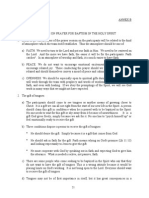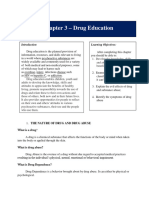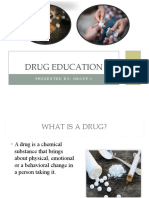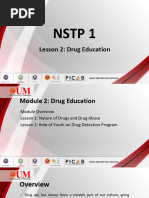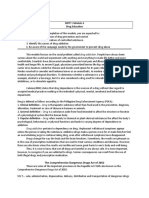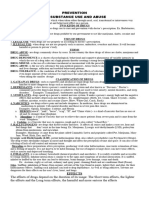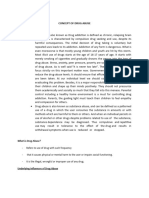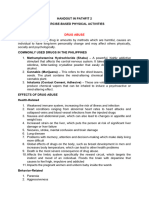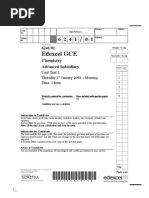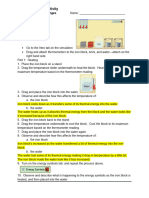0 ratings0% found this document useful (0 votes)
44 viewsSession 4. Drug Addiction NDEP
Session 4. Drug Addiction NDEP
Uploaded by
Christopher PontejoThe document discusses drugs and drug abuse. It defines drugs as substances that change physical and psychological well-being, noting some drugs are for medical purposes. Drug abuse is using drugs for non-medical reasons, while addiction is compulsive drug use despite harm. Factors influencing substance use include lack of parental support, peer pressure, pleasure from drugs, and using drugs to relieve stress or enhance performance. The document classifies and compares short and long-term effects of different drug types like stimulants, depressants, and hallucinogens. It recommends staying drug-free by living a healthy lifestyle, making good decisions, and respecting oneself.
Copyright:
© All Rights Reserved
Available Formats
Download as PDF, TXT or read online from Scribd
Session 4. Drug Addiction NDEP
Session 4. Drug Addiction NDEP
Uploaded by
Christopher Pontejo0 ratings0% found this document useful (0 votes)
44 views11 pagesThe document discusses drugs and drug abuse. It defines drugs as substances that change physical and psychological well-being, noting some drugs are for medical purposes. Drug abuse is using drugs for non-medical reasons, while addiction is compulsive drug use despite harm. Factors influencing substance use include lack of parental support, peer pressure, pleasure from drugs, and using drugs to relieve stress or enhance performance. The document classifies and compares short and long-term effects of different drug types like stimulants, depressants, and hallucinogens. It recommends staying drug-free by living a healthy lifestyle, making good decisions, and respecting oneself.
Original Description:
NDEP
Copyright
© © All Rights Reserved
Available Formats
PDF, TXT or read online from Scribd
Share this document
Did you find this document useful?
Is this content inappropriate?
The document discusses drugs and drug abuse. It defines drugs as substances that change physical and psychological well-being, noting some drugs are for medical purposes. Drug abuse is using drugs for non-medical reasons, while addiction is compulsive drug use despite harm. Factors influencing substance use include lack of parental support, peer pressure, pleasure from drugs, and using drugs to relieve stress or enhance performance. The document classifies and compares short and long-term effects of different drug types like stimulants, depressants, and hallucinogens. It recommends staying drug-free by living a healthy lifestyle, making good decisions, and respecting oneself.
Copyright:
© All Rights Reserved
Available Formats
Download as PDF, TXT or read online from Scribd
Download as pdf or txt
0 ratings0% found this document useful (0 votes)
44 views11 pagesSession 4. Drug Addiction NDEP
Session 4. Drug Addiction NDEP
Uploaded by
Christopher PontejoThe document discusses drugs and drug abuse. It defines drugs as substances that change physical and psychological well-being, noting some drugs are for medical purposes. Drug abuse is using drugs for non-medical reasons, while addiction is compulsive drug use despite harm. Factors influencing substance use include lack of parental support, peer pressure, pleasure from drugs, and using drugs to relieve stress or enhance performance. The document classifies and compares short and long-term effects of different drug types like stimulants, depressants, and hallucinogens. It recommends staying drug-free by living a healthy lifestyle, making good decisions, and respecting oneself.
Copyright:
© All Rights Reserved
Available Formats
Download as PDF, TXT or read online from Scribd
Download as pdf or txt
You are on page 1of 11
What is a Drug?
A drug is any substance in synthetic or natural
form, which changes an individual’s physical and
psychological well-being. There are drugs that are
necessary for medicinal purposes such as to cure
an illness or maintain health.
What is Drug Abuse?
Drug Abuse happens when a
drug is used for purposes other
than its medicinal or health
purposes.
What is Drug Addiction?
Drug addiction is a chronic disease characterized by
compulsive, or uncontrollable, drug seeking and use
despite harmful consequences and changes in the brain,
which can be long lasting. These changes in the brain can
lead to the harmful behaviors seen in people who use
drugs. Drug addiction is also a relapsing disease. Relapse
is the return to drug use after an attempt to stop.
Factors Influencing Substance
Use and Abuse
There are several factors which influence young
people to use and abuse substances. The following are
some of these factors:
1. Lack of Parental Supervision and Support
Teenagers who come from
broken families or lack
parental supervision and
support are vulnerable to
drug use and abuse.
2. Strong Peer Pressure and Curiosity
Adolescents are the most
vulnerable and are most
likely to try using substances
just because they feel the
need to belong and be
accepted.
3. Intense Feelings of Pleasure
Many substances abused
by drug users produce
euphoria. Euphoria is a
psychological state of
extreme cheerfulness and
high-spirited sensation.
4. Relief from Stress, Anxiety, and Depression.
Some people resort to the
use of drugs to relieve their
suffering from stress-
related disorders, anxiety
disorders, and depression.
5. Increased Physical and Cognitive Performance
Some people who need to
enhance their physical
performance and cognition
use drugs which chemically
enhance certain body
functions. Continued use,
however, leads to abuse,
addiction and even death.
Classification of Drugs
Stimulants
A commonly abused drug
that affects the central nervous
system raising the body’s
levels of physiological activity.
A person who takes a stimulant
feels more awake and more
active than usual. Stimulants
are also known by different
street names like “uppers,”
“speed,” and “heart.”
Short-Term Effects Long-Term Effects
1. Increased heart rate 1.Addiction
and palpitations 2. Feelings of hostility
2. Increased blood and paranoia
pressure 3. Dangerously high
3. Increased brain and temperature
body activity 4. Involuntary and
4. Raised body painful contraction
temperature of muscles
5. Inability to sleep 5. Visual hallucinations
6. Loss of appetite 6. Suicidal thoughts
and violent behavior
7. Dilated blood
vessels which
constricts blood flow
Depressants
A depressant, also called a sedative or
“downer,” is a drug which slows down the normal
function central nervous system. It makes the
heartbeat and respiratory rate slower than normal.
Short-Term Effects Long-Term Effects
1. Slow brain function 1. Addiction
2. Impaired judgement 2. Depression
3. Impaired senses 3. Chronic fatigue
4. Loss of coordination 4. Anxiety and panic
and balance attacks
5. Slurred speech 5. Impaired sexual
6. Lowers blood function
pressure 6. Infertility and
7. Lowers heart rate impotence
8. Lowers respiration 7. Chronic sleep
rate problems
9. Confusion and 8. Respiratory
disorientation depression and
respiratory arrest
9. Death
Hallucinogens
Hallucinogens, also known as psychedelic
drugs, alter a person’s view and concept of what
is real. This affects all of the body’s senses.
Short-Term Effects Long-Term Effects
1. Dilated or large 1. Addiction
pupils of the eyes 2. Severe fear, anxiety,
2. Headache and and stress
dizziness 3. Frightening illusions
3. Body tremors 4. Severe panic
4. Loss of appetite and attacks
stomach pains 5. Prolonged
5. Rapid heart rate depression
6. Rapid breathing 6. Insanity
7. Delusions and 7. Paranoia
confusion 8. Brain damage and
8. Difficulty sleeping mental disorders
9. Restlessness and 9. Suicidal tendencies
irritability 10. Psychosis
Narcotics
Narcotics are drugs used principally for
pain management and medication. They
produce numbing effects and induce sleep. It
primarily affects the central nervous system
thereby distorting a person’s perception of
things. Administration is done through
inhalation, intravenous injection, or oral intake.
Short-Term Effects Long-Term Effects
1. Sudden rise in 1. Blurred vision
sensations which is 2. Damage of various
called a “rush.” This systems like the
oftentimes comes circulatory,
with a warm feeling respiratory, and
in the skin, severe nervous system
itching, dryness of 3. Hypothermia or
the mouth, and lowering of body
vomiting temperature
2. Drowsiness 4. Death
3. Lower heart rate
4. Lower respiration
rate
5. Confusion
Chemical Inhalants
Chemical Inhalants are volatile substances
inhaled by users. Its vapor enters the body
through the nasal canal to the lungs, into the
bloodstream, and to the different parts of the
body.
Short-Term Effects Long-Term Effects
1. Drunk-like effects 1. Addiction
2. Severe headaches 2. Irritability
and dizziness 3. Easily gets irritated
3. Slurred speech 4. Severe depression
4. Foul breath 5. Lung diseases like
5. Rapid heart rate pneumonia
6. Rapid respiration 6. Organ damage
rate particularly the
7. Difficulty in heart, lungs, kidney,
coordinating body liver, and brain
parts
How to be Drug Free?
1. Having a Healthy Body
If you live a healthy lifestyle and surround
yourself with positive, supportive, and good
company, your chances of remaining drug-free
increases. Eat the right food, exercise, engage in
leisure activity with friends and family, and
enrich your mind through productive endeavors.
2. Take Control of Your Life
Taking control of one’s life means deciding to live a
clean, wholesome lifestyle, setting goals for oneself, and
focusing one’s efforts toward achieving those goals.
3. Respect Yourself and Others
Engage in productive, worthwhile activities that
make you a better person and enhance your self-
esteem. If you think highly of yourself and have
confidence in your talents and abilities, you will
develop self-respect and also gain the respect of
others.
4. Make Sound Decision
The quality of your life is the product of the
decisions you make. If you make sound and well-
thought of decisions you can have a happy,
productive life.
Every person should make it a goal to stay
drug-free throughout one’s life. Although certain
drugs may be necessary to cure an illness or
maintain good health, there are many things one
can do in order to avoid having to take
medication. One can begin by practicing and
maintaining a healthy lifestyle. This does not only
mean eating the right food, getting enough rest
and exercise, and maintaining good hygiene.
These are all important for physical health, but
one must make the same effort of looking after the
social, emotional, mental, and spiritual aspects of
one’s life. By doing so, one can move towards
achieving total wellness where there is little or no
need for drugs of any kind.
Sources://www.drugabuse.gov/publications/drugfacts/treatme
nt-approaches-drug-addiction, Our World of MAPEH (Vivian
Luge et al, 2014)
You might also like
- Prayer For Receiving The Holy SpiritDocument1 pagePrayer For Receiving The Holy SpiritChristopher Pontejo88% (8)
- Praying Over Session Talk 9Document4 pagesPraying Over Session Talk 9Christopher Pontejo100% (8)
- Project Report On Drugs AddictionDocument5 pagesProject Report On Drugs AddictionPillarisetty PremsaiNo ratings yet
- Chapter 9Document3 pagesChapter 9Fred GettingsNo ratings yet
- Chapter 3 - Drugs Education 1Document11 pagesChapter 3 - Drugs Education 1renan dealagdonNo ratings yet
- Chapter 2Document11 pagesChapter 2jessabongbongNo ratings yet
- National Service Training ProgramDocument23 pagesNational Service Training ProgramAngelica EstacionNo ratings yet
- NSTP SemiFinalsDocument11 pagesNSTP SemiFinalsAngeilyn Segador Roda - TambuliNo ratings yet
- Nstp2 Module 2 PremidtermDocument9 pagesNstp2 Module 2 PremidtermKent Maloloy-onNo ratings yet
- TanyaDrug Abuse. BiologyDocument19 pagesTanyaDrug Abuse. BiologySumita BiswalNo ratings yet
- Nstp-Cwts Module 3Document4 pagesNstp-Cwts Module 3JUAN VICTOR MACADANGDANGNo ratings yet
- Biology Project File On Drug AddictionDocument9 pagesBiology Project File On Drug AddictionALIENWARNo ratings yet
- LAS in Health 9 Q2 for Printing (2)Document12 pagesLAS in Health 9 Q2 for Printing (2)juanpangan27No ratings yet
- 2018 Genpsych - PsycdrugsDocument21 pages2018 Genpsych - PsycdrugsCzyvel KryzNo ratings yet
- What Is Drug Abuse?Document3 pagesWhat Is Drug Abuse?BOBOS, Joice A.No ratings yet
- Chapter 10 The Social Menace of Drug AddictionDocument4 pagesChapter 10 The Social Menace of Drug AddictionHarold PorrasNo ratings yet
- Lesson 5Document51 pagesLesson 5kintaximaNo ratings yet
- LAS in Health 9 Q2 For PrintingDocument12 pagesLAS in Health 9 Q2 For PrintingCris John CruzNo ratings yet
- Drug EducationDocument89 pagesDrug EducationLouie ManabatNo ratings yet
- Wondergirl: The Effect Drug of Human BodyDocument29 pagesWondergirl: The Effect Drug of Human Bodygs_sharonNo ratings yet
- Biology Investigatory ProjectDocument17 pagesBiology Investigatory ProjectAnonymous CreationsNo ratings yet
- What Is Drug AddictionDocument2 pagesWhat Is Drug AddictiontarachandmaraNo ratings yet
- Assessment Module 4 Drug PreventionDocument3 pagesAssessment Module 4 Drug Preventionbmaria krizzaNo ratings yet
- NSTP 1-Lesson 2_Drug EducationDocument65 pagesNSTP 1-Lesson 2_Drug Educationkarmakoon18No ratings yet
- Presentation 3Document24 pagesPresentation 3api-619211764No ratings yet
- Seminar Drug AddictionDocument49 pagesSeminar Drug AddictionJOHN ARBIE TATTAO, RN82% (17)
- PREFINAL The Social Menace of Drug AddictionDocument26 pagesPREFINAL The Social Menace of Drug Addictionjane guinumtadNo ratings yet
- Drug Addiction Causes and Remedial MeasuresDocument15 pagesDrug Addiction Causes and Remedial Measuresnitin0010No ratings yet
- Bio ProjectDocument19 pagesBio Projectjai tomNo ratings yet
- NSTP 1 - SEMIFINAL COVERAGEDocument13 pagesNSTP 1 - SEMIFINAL COVERAGEthefutureispink10No ratings yet
- DrugsDocument7 pagesDrugsitsmesuvekshaNo ratings yet
- Lesson Plan Mapeh 2ND QuarterDocument7 pagesLesson Plan Mapeh 2ND QuarterJENY VEV GAYOMANo ratings yet
- Hallucinogens Can Be Man-Made, or They Can Come From Plants or Mushrooms or Extracts From Plants and MushroomsDocument2 pagesHallucinogens Can Be Man-Made, or They Can Come From Plants or Mushrooms or Extracts From Plants and MushroomsMichiko MlNo ratings yet
- Module3 CWTS001Document2 pagesModule3 CWTS001sophiamorcozo1208No ratings yet
- Drug EducationDocument50 pagesDrug EducationrtuppilNo ratings yet
- Introduction To Drugs: by Ayaan KaraniDocument10 pagesIntroduction To Drugs: by Ayaan Karaniayaankarani40No ratings yet
- BIOLOGY PROJECT: Drugs Addiction: Teo Nikolov, XI GradeDocument7 pagesBIOLOGY PROJECT: Drugs Addiction: Teo Nikolov, XI GradeTeo NikolovNo ratings yet
- NSTP Lecture 4 Drug AddictionDocument11 pagesNSTP Lecture 4 Drug AddictionRona CabuguasonNo ratings yet
- Project On Drug AddictionDocument17 pagesProject On Drug Addictionyash VermaNo ratings yet
- Drugs, Drug Abuse and Related LawsDocument47 pagesDrugs, Drug Abuse and Related LawsMiyangNo ratings yet
- NSTP CWTS 1 Module 10Document4 pagesNSTP CWTS 1 Module 10Niña Edrienne JuntillaNo ratings yet
- NSTP 1 Module 4 Drug Education Objectives: The Comprehensive Dangerous Drugs Act of 2002Document5 pagesNSTP 1 Module 4 Drug Education Objectives: The Comprehensive Dangerous Drugs Act of 2002Juliet ArdalesNo ratings yet
- DOC-20241021-WA0023.Document15 pagesDOC-20241021-WA0023.ianx5899No ratings yet
- 9 SocSt Ed 313 Drug AbuseDocument7 pages9 SocSt Ed 313 Drug AbuseHannafer EchavezNo ratings yet
- Drug Education Wps OfficeDocument15 pagesDrug Education Wps OfficeMaan GasmenNo ratings yet
- HEALTH 9 Handouts 2nd QuarterDocument3 pagesHEALTH 9 Handouts 2nd QuarterTrinity Marie HablanNo ratings yet
- Bio ProjectDocument17 pagesBio Projectjai tomNo ratings yet
- Lalita Health April 25, 2011Document7 pagesLalita Health April 25, 2011Pornpat SiriphanpornNo ratings yet
- Drug EdDocument6 pagesDrug EdCreedNo ratings yet
- Mapeh ReportDocument60 pagesMapeh Reportnelie tumpapNo ratings yet
- Module For LESSON 3Document9 pagesModule For LESSON 3Maira Garcia C.No ratings yet
- Drug Abuse 1 - 105147Document50 pagesDrug Abuse 1 - 105147Mrethunjoy DebnathNo ratings yet
- Week 4 Note On Drug AbuseDocument19 pagesWeek 4 Note On Drug AbuseJuanita Jude-AsogwaNo ratings yet
- Introduction of "Drugs Addiction": What Is Meant by DrugDocument15 pagesIntroduction of "Drugs Addiction": What Is Meant by DrugramakntaNo ratings yet
- Module 6 - CwtsDocument9 pagesModule 6 - CwtsAmor Lisondra LegitimasNo ratings yet
- Handout in Pathfit 2Document13 pagesHandout in Pathfit 2maericka.talaveraNo ratings yet
- 0 - 321113728 Chemistry Investigatory Project On Drugs Addiction Abuse PDFDocument10 pages0 - 321113728 Chemistry Investigatory Project On Drugs Addiction Abuse PDFPardhyuman Bhadu100% (1)
- Unit II Health 9 Lesson 1 3 Prevention of Substance Use and Abuse Wo VideosDocument77 pagesUnit II Health 9 Lesson 1 3 Prevention of Substance Use and Abuse Wo VideosGwy TuazonNo ratings yet
- What Is Meant by Drug: Type of Drug Examples EffectDocument5 pagesWhat Is Meant by Drug: Type of Drug Examples EffectUdya KrishnaNo ratings yet
- Ill Effects of Vices: Drug Abuse and PreventionDocument23 pagesIll Effects of Vices: Drug Abuse and PreventionMariz Bautista0% (1)
- Chapter 5Document8 pagesChapter 5Arhann Anthony Almachar Adriatico100% (1)
- Exposing the Shameful Face of Drug Addiction: Unveiling the trick behind drug addictionFrom EverandExposing the Shameful Face of Drug Addiction: Unveiling the trick behind drug addictionNo ratings yet
- Ang Pasko Ay Sumapit UpdatedDocument1 pageAng Pasko Ay Sumapit UpdatedChristopher PontejoNo ratings yet
- 201 Files ChecklistDocument1 page201 Files ChecklistChristopher Pontejo100% (1)
- Yfc Song 033019Document1 pageYfc Song 033019Christopher PontejoNo ratings yet
- Quarter 1 - Module 2: Bread and Pastry Production: TLE - Self-1Document20 pagesQuarter 1 - Module 2: Bread and Pastry Production: TLE - Self-1Christopher PontejoNo ratings yet
- Letter For PriestDocument1 pageLetter For PriestChristopher PontejoNo ratings yet
- Collaborative LearningDocument11 pagesCollaborative LearningChristopher PontejoNo ratings yet
- Peace Activities Palkan NHSDocument2 pagesPeace Activities Palkan NHSChristopher PontejoNo ratings yet
- Finger Math PresentationDocument18 pagesFinger Math PresentationChristopher PontejoNo ratings yet
- Inventory of Computer Facilities and Internet Connectivity in SchoolsDocument3 pagesInventory of Computer Facilities and Internet Connectivity in SchoolsChristopher PontejoNo ratings yet
- Readings: Tuesday of The Fourth Week in Advent Lectionary: 196Document2 pagesReadings: Tuesday of The Fourth Week in Advent Lectionary: 196Christopher PontejoNo ratings yet
- Glory and Praise Amen: You Are NearDocument2 pagesGlory and Praise Amen: You Are NearChristopher PontejoNo ratings yet
- Math CGDocument218 pagesMath CGPergie Telarma100% (5)
- Case Study 4Document12 pagesCase Study 4Christopher Pontejo63% (8)
- Itinerary of TravelDocument12 pagesItinerary of TravelChristopher PontejoNo ratings yet
- Briefer 2Document2 pagesBriefer 2Christopher PontejoNo ratings yet
- Time Card: Name: FS Course: FS Course Discription: Date Time Subject Teacher's Name Time in Signature Time Out SignatureDocument2 pagesTime Card: Name: FS Course: FS Course Discription: Date Time Subject Teacher's Name Time in Signature Time Out SignatureChristopher PontejoNo ratings yet
- Tongue Workshop Talk OutlineDocument6 pagesTongue Workshop Talk OutlineChristopher Pontejo100% (1)
- Routine MemoDocument1 pageRoutine MemoChristopher PontejoNo ratings yet
- H1 Pumps 078-115-130-147-165 - Service Manual - 520L0848 - Rev AB - April 2008Document60 pagesH1 Pumps 078-115-130-147-165 - Service Manual - 520L0848 - Rev AB - April 2008Jose Manuel Barroso Pantoja100% (1)
- Exposing BizTalk Service To Azure PDFDocument12 pagesExposing BizTalk Service To Azure PDFKarthik NimmaturiNo ratings yet
- 2022 2023 Algebra 1 Honors SyllabusDocument5 pages2022 2023 Algebra 1 Honors SyllabusMarley SpuhlerNo ratings yet
- Jaime GarzónDocument2 pagesJaime GarzónJULIANA CANO MADRIDNo ratings yet
- Chacon SimuladorDocument4 pagesChacon SimuladorJose Maria Quintas GironNo ratings yet
- Giáo Án TA 3 I-Learn Smart Start Unit 8 - Lesson 1 - Page 110Document4 pagesGiáo Án TA 3 I-Learn Smart Start Unit 8 - Lesson 1 - Page 110tphuong1862No ratings yet
- Kelly Maeshiro - ResumeDocument2 pagesKelly Maeshiro - ResumekellymaeshiroNo ratings yet
- Boarding PassDocument3 pagesBoarding PassAbhishek GorisariaNo ratings yet
- Loss of Field Protection: ANSI 40 (For Motor) : P&EC/T&i/ Nov. 2006 Plan - ANSI 40 - MotorDocument5 pagesLoss of Field Protection: ANSI 40 (For Motor) : P&EC/T&i/ Nov. 2006 Plan - ANSI 40 - MotorYousefNo ratings yet
- PPT-09 SancharsoftDocument20 pagesPPT-09 Sancharsofthem777No ratings yet
- Isaac's Storm Reader's Guide #10 - "The Devil's Voice", "Swells", and "Heat"Document3 pagesIsaac's Storm Reader's Guide #10 - "The Devil's Voice", "Swells", and "Heat"Brandon CooperNo ratings yet
- Entrepreneurship and Small Business Management AssignmentDocument20 pagesEntrepreneurship and Small Business Management Assignmentasif2022coursesNo ratings yet
- Advertisement Notice No. 01 of 2014 Dated: 13 .08. 2014Document25 pagesAdvertisement Notice No. 01 of 2014 Dated: 13 .08. 2014Err33No ratings yet
- (International Series in Pure and Applied Physics) Floyd K. Richtmyer, Earle H. Kennard - Introduction To Modern Physics-McGraw-Hill Book Company, Inc. (1947)Document780 pages(International Series in Pure and Applied Physics) Floyd K. Richtmyer, Earle H. Kennard - Introduction To Modern Physics-McGraw-Hill Book Company, Inc. (1947)jor marketing100% (2)
- 6241 01 Que 20080117Document16 pages6241 01 Que 20080117M S RahmanNo ratings yet
- Module 8 Business FinanceDocument32 pagesModule 8 Business Financemalindabissoon312No ratings yet
- Napkin FoldingDocument8 pagesNapkin Foldingchielseygetalada0101No ratings yet
- Hajiba ABERRAN REPORT MEDIA AND TRANSLATIONDocument2 pagesHajiba ABERRAN REPORT MEDIA AND TRANSLATIONhajiba AberranNo ratings yet
- Crystallization and DecolorizationDocument5 pagesCrystallization and DecolorizationHanna Shaira33% (9)
- Chapter 1: The Problem and Its ContextDocument3 pagesChapter 1: The Problem and Its ContextRonaldNo ratings yet
- MutantesoctaveDocument8 pagesMutantesoctaveChris HussNo ratings yet
- Passive Voice in English and Vietnamese - A Contrastive AnalysisDocument14 pagesPassive Voice in English and Vietnamese - A Contrastive AnalysisTran ThanhNo ratings yet
- Doubt QuestionsDocument3 pagesDoubt Questionstanya1780No ratings yet
- PHET Energy Forms and ChangesDocument8 pagesPHET Energy Forms and Changesadamabuelhaija2No ratings yet
- Prozac Nation Young and Depressed in America Wurtzel download pdfDocument52 pagesProzac Nation Young and Depressed in America Wurtzel download pdflilisypsomas100% (2)
- Language Dysfunction - Continnum - 2015Document19 pagesLanguage Dysfunction - Continnum - 2015Carolina Posada OrtizNo ratings yet
- Hecr Cosmic RaysDocument82 pagesHecr Cosmic RaysriomjNo ratings yet
- The Vanity of The RatDocument1 pageThe Vanity of The RatSean BustosNo ratings yet
- 11th Physics EM 1 Mark Questions English Medium PDF DownloadDocument20 pages11th Physics EM 1 Mark Questions English Medium PDF DownloadStar33% (6)

